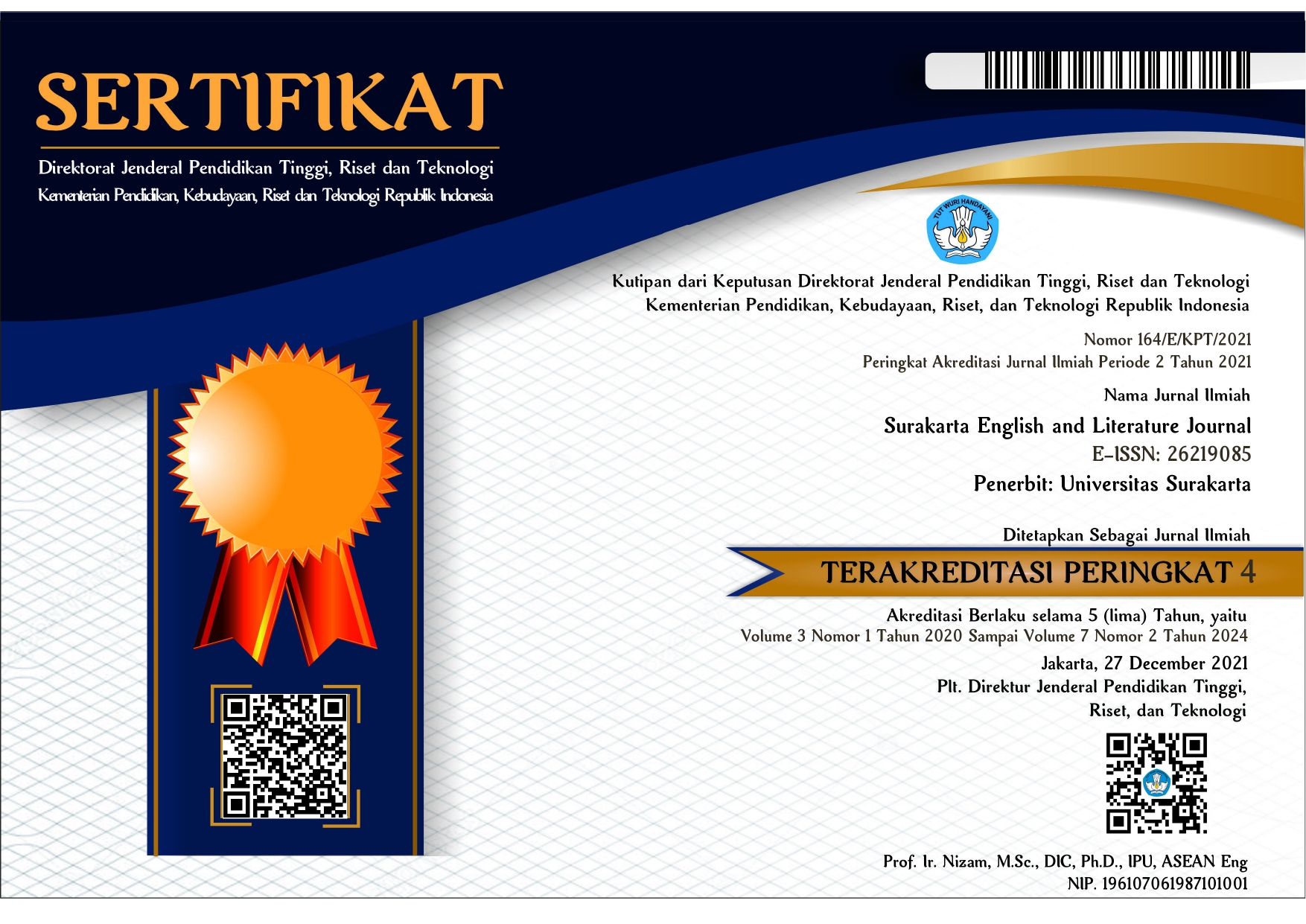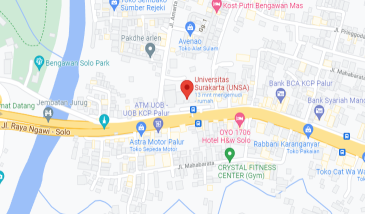The Adjacency Pairs in the Bing Bunny Animated Series
DOI:
https://doi.org/10.52429/selju.v6i2.117Keywords:
adjacency pairs, Bing Bunny, animated series, childrenAbstract
An animated series narrated about a preschool bunny named Bing shows how he interacts with the world around him with the support of his caretaker through little everyday experiences. The goal of this study is to explore the pattern of adjacency pairs among Bing and his friends with their caregivers in the Bing Bunny animated series. This study applied qualitative methods and conversational analysis. The data was gathered from the conversation of all characters in Bing Bunny's official channel on YouTube. The result shows that adjacency pairs in five episodes of the Bing Bunny animated series consist of 10 types. They are greeting-greeting, summon-answer, question-answer, request-acceptance, request-refusal, offer-accept, blame-denial, apology-minimization, assertion-agreement, announcement-acknowledgement. The adjacency pair patterns reveal the successful engagement among the children and the caregivers. The exposure of adjacency pairs to children will contribute to language acquisition, cognitive development, social understanding, and overall learning.
References
Aloyan, A. (2014). Preferred and Dispreffered Second Parts of Question-Answer Adjacency Pairs. Foreign Languages in Higher Education, 18(1), 3–13. https://doi.org/https://doi.org/10.46991/FLHE/2014/18.1.003
Arsyad, L., Akhmad, E., & Habibie, A. (2021). Membekali anak usia dini dengan pendidikan karakter: Analisis cerita film animasi Upin dan Ipin. WASKITA: Jurnal Pendidikan Nilai Dan Pembangunan Karakter, 5(1).
Averina, F. E. (2023). A Pragmatic Analysis of Flouting Maxims in Classroom Verbal Interaction as Seen in Freedom Writers Movie. Surakarta English and Literature Journal, 6, 2621–9077.
Bodur, K., Nikolaus, M., Kassim, F., Prévot, L., & Fourtassi, A. (2021). ChiCo: A Multimodal Corpus for the Study of Child Conversation. In Z. Hammal, C. Busso, C. Pelachaud, S. Oviatt, A. A. Salah, & G. Zhao (Eds.), ICMI ’21 Companion: Companion Publication of the 2021 International Conference on Multimodal Interaction (pp. 158–163). Association for Computing Machinery. https://doi.org/https://doi.org/10.1145/3461615.3485399
Bublitz, W. (2006). Sacks, Harvey (1935–1975). In K. Brown (Ed.), Encyclopedia of Language and Linguistics (2nd edition, pp. 721–723).
Fardani, D. N., & Lismanda, Y. F. (2019). Nilai-Nilai Pendidikan Karakter untuk Anak Usia Dini dalam Film Nussa. Thufuli : Jurnal Ilmiah Pendidikan Islam Anak Usia Dini, 1(2), 34–49. https://doi.org/https://doi.org/10.33474/thufuli.v1i2.4921
Filipi, A. (2009). Toddler and Parent Interaction: The organisation of gaze, pointing and vocalisation. John Benjamins Publishing Company.
Gunnarsdottir, B., & Bateman, A. (2017). Toddler agency and conversation analysis. Early Childhood Folio, 21(1), 33–38.
Hanks, W. (2006). Context, Communicative. In K. Brown (Ed.), Encyclopedia of Language and Linguistics (2nd Editio, pp. 115–128).
Heath, S. B., & Thomas, C. (1992). The Achievement of Preschool Literacy for Mother and Child. In J. R. Hayes, R. E. Young, M. L. Matchet, M. MacCafrey, & C. Cochran (Eds.), Reading Empirical Research Studies (1st edition, p. 28). Routledge.
Hidayah, N., Lestari, G. D., & Artha, I. K. A. J. (2022). Parent and Child Communication Patterns in Early Childhood Emotional Social Development. Proceedings of the International Joint Conference on Arts and Humanities 2021 (IJCAH 2021), 618, 1130–1135. https://doi.org/10.2991/assehr.k.211223.197
Iswara, J. W., Rukmini, D., & Widhiyanto, W. (2019). The adjacency pair patterns in spoken interaction of roundtable discussion with Susi Pudjiastuti. English Education Journal, 9(3), 297–299.
Kepins, S. (2022). Bing: One of the Best Shows for Preschool Age Kids. Movieweb.
Knight, J. (2017, July). Parent-Child Conversation: More Than Just Idle Chatter. Iowa Reading Research Center.
Koyama, W. (2006). Pragmatics and Semantics. In K. Brown (Ed.), Encyclopedia of Language and Linguistics (2nd ed., pp. 25–32). Elsevier Pergamont.
Kurniasih, E., & Ramadhianti, A. (2022). Character Values in Bing Bunny Animated Series. Sinastra, 1(July), 12–19.
Kusumawati, E. A., Listianingsih, E., & Hidayah, R. (2019). Parents Communication Patterns to The Development of Children’s Personality. Social, Humanities, and Educational Studies (SHEs): Conference Series, 2(1), 252. https://doi.org/10.20961/shes.v2i1.38116
Lestari, G. D., Izzati, U. A., & Indriani, D. E. (2020). The Role of Mother’s Communication Patterns on the Children’s Language Development. Talent Development & Excellence, 12(1), 343–351.
Levinson, S. C. (1983). Pragmatics. Cambridge University Press.
Mun, Y. E., & Lee, J.-Y. (2021). The Influence of Parenting Attitudes and Conversation Hours Between Parent and Child on Children’s Happiness. Korean J of Childcare & Education, 17(1), 85–104. https://doi.org/https://doi.org/10.14698/jkcce.2021.17.01.085
Munir, F. (2016). The Effectiveness Of Teaching Vocabulary By Using Cartoon Film Toward Vocabulary Mastery Of EFL Students. Journal of English Language Teaching and Linguistics, 1(1), 13–37.
Nurnaningsih. (2021). The Use of Flashcard in Teaching English Vocabularies by Young Mothers. Surakarta English and Literature Journal, 4(1), 44–55.
Phelan, N. (2015). Bing Bunny. Acamar Film Limited.
Purwoko, H. (2008). Discourse Analysis : Kajian Wacana Bagi Semua Orang. Indeks.
Ramirez, N. F., Lytle, S. R., & Kuhl, P. K. (2019). Parent coaching increases conversational turns and advances infant language development. PNAS, 117(7), 3484–3491.
Schegloff, E. A. (2007). Sequence organization in interaction: A primer in conversation analysis. Cambridge University Press.
Sudartinah, T. (2023). A Conversation Analysis of Two-year- old Children 's Speech in Child-Adult Interactions. Jurnal Obsesi : Jurnal Pendidikan Anak Usia Dini, 7(3), 3345–3356. https://doi.org/10.31004/obsesi.v7i3.4586
Widiyastuti, W., & Rustono. (2018). Seloka : Jurnal Pendidikan Bahasa dan Sastra Indonesia Adjacency Pair of Conversation on Interactional Discourse in High School Learning. 7(08), 293–299.
Wiratno, T., Sumarlam, S., & Susanti, R. (2018). Adjacency Pairs and Implicature of Utterances President Joko Widodo in the Episode of Di Balik Dinding Istana of the Mata Najwa TV Program. 166(Prasasti), 440–443. https://doi.org/10.2991/prasasti-18.2018.81
Zimmerman, F. J., Richards, J. A., Christakis, D. A., Xu, D., Gray, S., & Yapanel, U. (2009). Teaching by Listening: The Importance of Adult-Child Conversations to Language Development. Pediatrics, 124(1), 342–349. https://doi.org/https://doi.org/10.1542/peds.2008-2267
Downloads
Published
How to Cite
Issue
Section
License
Copyright (c) 2023 Euis Kurniasih

This work is licensed under a Creative Commons Attribution-ShareAlike 4.0 International License.
Licensing for Data Publication
-
Open Data Commons Attribution License, http://www.opendatacommons.org/licenses/by/1.0/ (default)
-
Creative Commons CC-Zero Waiver, http://creativecommons.org/publicdomain/zero/1.0/
-
Open Data Commons Public Domain Dedication and Licence, http://www.opendatacommons.org/licenses/pddl/1-0/














